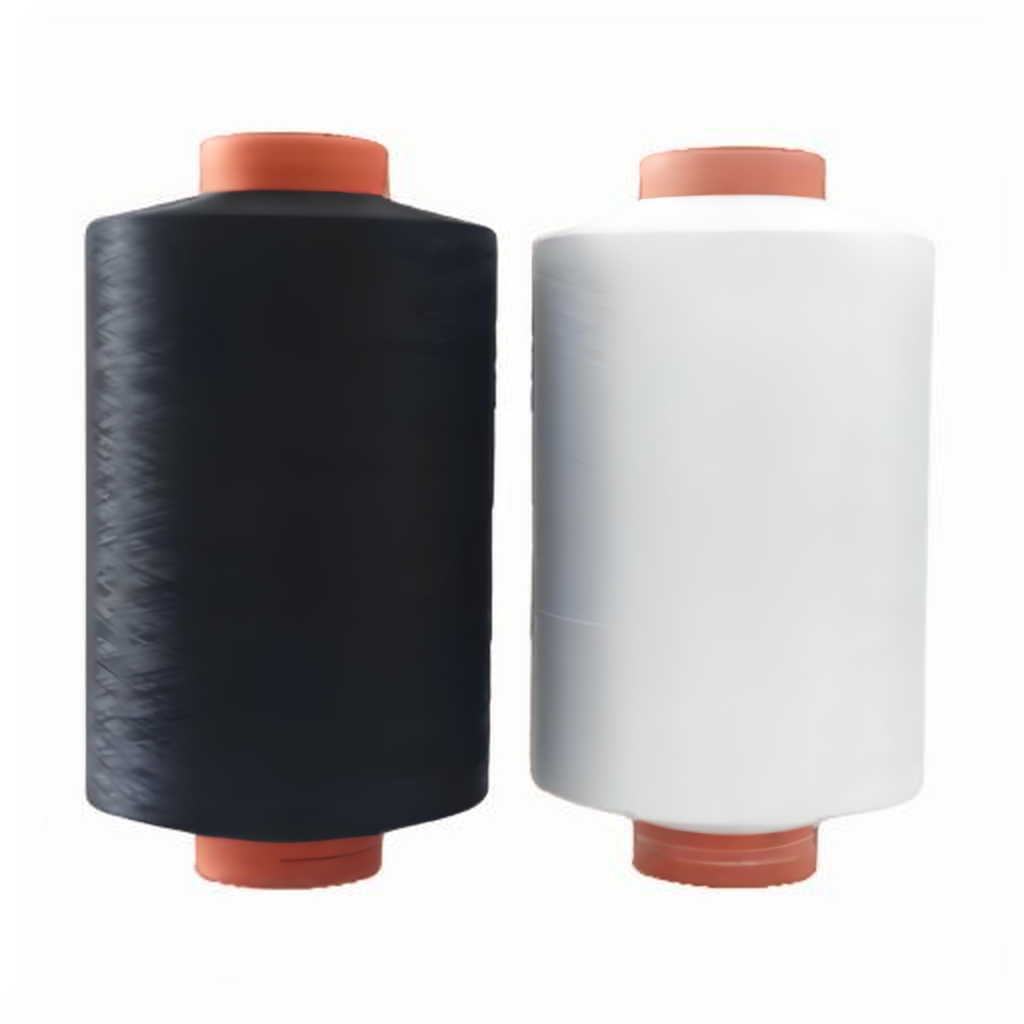What Is POY Yarn (Polyester Partially Oriented Yarn)? - China Yarns Manufacturer And Supplier
Polyester Partially Orientated Yarn, or “What is POY Yarn?”
Made under a regulated procedure wherein the polymer is partly orientated, often known as partly Orientated Yarn, is a semi-textured polyester filament yarn This method produces a yarn with particular mechanical and structural qualities fit for many different textile uses. Because of its production from pure polyester basic materials and semi-finished shape, it is also referred to as Polyester Pre-Oriented Yarn.

The first appearance of POY.
POY’s molecular structure, which is partly oriented—that is, the polymer chains are aligned to a certain degree—but not to the full amount needed for high-performance yarns like fully drawn yarn (FDY). This partial orientation produces a yarn with an elasticity and strength level midway between others. Further processing into a range of textured and high-performance yarns used in textiles is done from POY.
Usually starting with the raw ingredients, Polyethylene Terephthalate (PET), which are derived from monoethylene glycol (MEG) and purified terephthalic acid (PTA), As another alternative, the material may come from melted polyester chips spun into filament form. it is a semi-finished yarn that is not yet completely drawn or completed but is nevertheless a crucial intermediary product in the manufacturing of many different kinds of textile yarns.
POY’s (partially orientated yarn) production process
The manufacture of POY starts with polyester raw material polymerising. Purified terephthalic acid (PTA) and monoethylene glycol (MEG)are the two main ingredients used in the polyester manufacture; their polycondensation reaction forms the polyester polymer. The molten polyester is chilled to a designated temperature after the polymerisation process is finished; it is then filtered and pressurised before being fed to the spinning manifolds.
At this point the polyester is extruded via spinnerets, specialised nozzles that produce many fine filaments concurrently. The power of spinning pumps—which are pushed at different rates—draws these filaments into an endless thread. Quenching—a technique wherein the filaments are subjected to carefully regulated, conditioned, and filtered air—cools the resultant fibres. The chilling process guarantees that, throughout formation, the filaments harden and retain their shape.
A finish coating is done to the filaments after cooling to lubricate them and stop them from sticking together in next manufacturing phases. High-speed winders then neatly gather and store the filaments as they are coiled into bobbins. The finished product is Partially Orientated Yarn, a fine, continuous filament yarn.
Usually derived from polyester chips either white or coloured, POY stands out for its semi-opaque, brilliant look of the yarn. Many times, coloured masterbatches with pigments are included into the manufacturing process, therefore removing the need for further dying in later phases. Especially useful in situations where the yarn will be used in the manufacture of coloured fabric, these masterbatches provide uniform and vivid colouration throughout the skein.
characteristic traits of POY:
Among different varieties of polyester yarns, Fully Drawn Yarn (FDY) or Drawn Textured Yarn (DTY) POY stands out for a few salient features. Among them are its semi-oriented molecular structure, which lets it strike a mix of rigidity and strength. POY has several noteworthy characteristics including:

The process of transforming POY into DTY involves a series of sophisticated textile process steps that work together to impart new properties and characteristics to it.
Partially Oriented Yarn is suitable for usage in a range of textile goods as its partly orientated character results in a modest degree of strength. It is not as robust or lasting, however, as FDY, which goes through a more thorough drawing process to more fully align the polymer strands.
High elasticity:Because POY has some elasticity, the yarn may recover to its original form after stretching or deformation. Applications like textile manufacture, which flexibility and drape are sought for, depend on this quality.
– Good heat resistance: POY has great heat resistance, as with other polyester-based fibres, which qualifies for usage in high-temperature surroundings or for garments that will be extensively ironed or steamed.
Lower Shrinkage: POY is perfect for use in clothing that must preserve their form over time as its shrinkage rates are usually low compared to other fibres.
POY is essentially a semi-finished product, ready to be further worked into many kinds of yarns including Drawn Textured Yarn (DTY), Interlaced Textured Yarn (ITY), and Air Textured Yarn (ATY). Usually utilised in the manufacturing of clothes needing a soft, tactile feel or a certain appearance, these last yarns
Partially Orientated Yarn: POY’s application
POY is mostly used as an intermediary product that is then textured or drawn to produce textured yarns, including Drawn Textured Yarn (DTY). The texturising process adds crimp, curls, or other structures into the yarn using mechanical or air-based techniques, therefore improving its texture and producing a softer, more flexible result fit for different fabric kinds.
Apart from texturising, POY finds usage in various fields like draw warping, a technique used in knitting and weaving to generate textiles with warp threads. Stretching the yarn helps to produce a strong and consistent warp that will subsequently be employed in the knitting or weaving operations.
Other important uses of POY consist in:
Apparel Manufacturing:Because POY is a flexible yarn that can be worked into many kinds of textiles, it is utilised widely in the manufacture of shirtings, suitings, and ladies’ dress materials. The yarn’s enhanced drape, wrinkle resistance, and crease healing qualities make it perfect for clothing that must look great after several wears.
Home Textiles Home textiles include curtains, upholstery fabrics, and bedding also are produced with POY. It’s a great option for house uses because of its durability to wear and tear and colour and texture holding power.
Regarding knits:POY is used in the knitwear industry to produce soft, robust materials with comfort and lifetime in mind. High-quality knitwear is produced with great consideration for the yarn’s capacity to hold colour and form during washing and use.
Sportswear and Performance Textiles:Sportswear and performance textiles, where flexibility and breathability are paramount, fit POY’s moisture-wicking qualities and elasticity. Its resistance to shrinking and capacity to hold form make it an excellent material for sportswear as well.
POY Yarn’s advantages in textile production
Especially in the manufacturing of premium textiles, POY has various benefits over other kinds of yarns. among the main advantages are:
Excellent drape of POY yarns is vital for manufacturing clothing and textiles that fall beautifully and preserve their form. The yarn’s partial orientation helps to strike a mix between rigidity and suppleness.
POY yarn is an excellent option for uses where a smooth, crisp look is sought as its molecular structure and processing increase its degree of wrinkle resistance over that of other synthetic fibres.
POY yarn is more robust than other fibres such Polyester Staple Fibre (PSF), Viscose Staple Fibre (VSF), and Nylon Filament Yarn (NFY). This makes it especially helpful in uses where the cloth will be used often and subjected to damage.
POY yarn has great colour retention qualities as it can be manufactured using coloured masterbatues. This makes it a desirable component for the manufacturing of fabrics and clothing requiring vivid, long-lasting colours.
The Role of POY in Textile Manufacturing
As a semi-finished product that may be further worked into a range of textured and high-performance yarns, polyester partially orientated yarn (POY) is very vital in the textile sector. From clothing and home textiles to sportswear and knitting, its special qualities—moderate strength, flexibility, and heat resistance—make it a necessary material for the manufacturing of fabrics used in a broad spectrum of applications. POY enhances the general quality, performance, and visual appeal of the completed textile goods by offering a middle ground between raw polyester chips and finished, textured yarns.
Previous News
Industrial yarn is the core material for many i...Next News
Polyester Yarn vs Recycled Polyester
By Yarn
Feature Product
-
 DTY 100D/144F Polyester Yarn
DTY 100D/144F Polyester YarnDTY 100D/144F Polyester Yarn: The Ultimate Guid...
-
 DTY 100D/96F Polyester Yarn
DTY 100D/96F Polyester YarnDTY 100D/96F Polyester Yarn: The Soft, Stable S...
-
 DTY 75D/144F SIM Polyester Yarn
DTY 75D/144F SIM Polyester YarnDTY 75D/144F SIM Polyester Yarn: A Top Choice f...